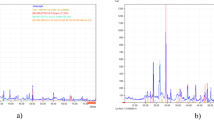Abstract
This study analyzes the behaviour of waterglass- or NaOH-activated slag mortars after carbonation. The effect of a superplasticizer based on vinyl copolymer and shrinkage reducing polypropylenglycol derivative admixtures on that process was also examined. The same tests were run on cement mortars for reference purposes. The mortars were carbonated in a chamber ensuring CO2 saturation for four and eight months, after which ages the samples were tested for mechanical strength; mercury porosimetry and mineralogical (XRD, FTIR) and microstructural characterization (SEM/EDX) were also conducted. The results obtained indicate that alkali-activated slag mortars were more intensely and deeply carbonated than Portland cement mortars. Carbonation took place directly on the gel, causing decalcification. When waterglass was the alkaline activator used, carbonation caused a loss of cohesion in the matrix and an important increase in porosity and decrease in mechanical strength. When a NaOH solution was used as the alkali activator, carbonation enhanced mortar compaction and increased mechanical strength. Finally, in waterglass-activated slag mortars, the inclusion of organic admixtures had no effect either on their behaviour after carbonation or the nature of the reaction products.
Similar content being viewed by others
References
V. D. GLUKHOVSKY, G. S. ROSTOVSKAJA and G. V. Y RUMYNA, in 7th International Congress Chemistry Cement (Paris) (1980) vol. 164–168, p. 3.
P. V. KRIVENKO, in 9th International Congress Chemistry Cement (New Delhi) (1992) vol. 4, p. 481.
S. D. WANG, K. L. SCRIVENER and P. L. PRATT, Cement and Concrete Res. 24(6) (1994) 1033.
A. FERNÁNDEZ-JIMÉNEZ, F. PUERTAS and J. G. PALOMO, ibid. 29(3) (1999) 593.
S. D. WANG, X. C. PU, K. L. SCRIVENER and P. L. PRATT, Advances in Cement Res. 7(27) (1995) 93.
F. PUERTAS, Mater. Construcc. 45(239) 53.
T. BAKHAREV, J. SANJAYAN and Y.-B. CHENG, Cement and Concrete Res. 29 (1999) 113.
C. SHI, ibid. 26 (1996) 1789.
T. BAKHAREV, J. G. SANJAYAN and Y.-B. CHENG, ibid. 32 (2002) 211.
F. PUERTAS, R. DE GUTIERREZ, A. FERNÁNDEZ-JIMÉNEZ, S. DELVASTO and J. MALDONADO, Mater. Construcc. 52(267) (2002) 55.
C. SHI, Advances in Cement Res. 15(2) (2003) 77.
PU XINCHENG, YANG CHANGHUI and LIU FAN, Second International Conference Alkaline Cements and Concretes (1999) p. 717.
T. BAKHAREV, J. G. SANJAYAN, and Y.-B. CHENG, Cem. and Con. Res. 33 (2003) 1607.
F. PUERTAS, T. AMAT, A. FERNÁNDEZ-JIMÉNEZ, T. VÓZQUEZ, ibid. 33 (2003) 2031.
XU BIN and PU XINCHENG, Second International Conference Alkaline Cements and Concretes (1999) p. 101.
B. TAILING and J. BRANDSTETR, in Proc. 3rd Int. Conf. On Fly Ash, Silica Fume, Slag and Natural Pozzolans in Concrete, Trondheim, (1989), 2, SP114-74, p. 1519.
R. MEJÍA DE GUTIERREZ, J. MALDONADO, C. GUTIÉRREZ, Mater. Construcc. 54(276) (2004) p. 87.
S. D. WANG. and K. SCRIVENER, Cem. Con. Res. 25(3) (1995) p. 561.
J. I. ESCALANTE-GARCÍA, A. F. FUENTES, A. GOROKOVSKY, P. E. FRAIRE-LUNA and G. MENDOZA-SUAREZ, J. Am. Ceram. Soc. 86(12) (2003) 48.
A. FERNÁNDEZ-JIMÉNEZ, F. PUERTAS, I. SOBRADOS and J. SANZ, ibid. 86(8) (2003) 1389.
N. R. SHORT, A. R. BROUGH, A. M. G. SENEVIRATNE, P. PURNELL and C. L. PAGE, J. Mater. Sci. 39 (2004) 5683.
Y. F. HOUST and F. H. WITTMANN, Cem. Concr. Res. 32 (2002) 1923.
K. BYFORS, et al. in Proc. 3rd Int. Conf. on Fly Ash, Silica Fume, Slag and Natural Pozzolans in Concrete. Trondheim (1989) SP114-70, vol. 2, p. 1547.
X. C. PU, et al. “Sumary reports of Research on Alkali-Activated Slag Cement and Concrete” (Chongqing Institute of Architecture and Engineering, 1988), 6 vols (in Chinese).
J. DEJA, Sil. Ind. 67(3–4) (2002) 37.
T. BAKAREV J. G. SANJAYAN and Y.-B. CHENG, Cem. Concr. Res. 31 (2001) 1277.
E 104-02 ASTM, “Maintaining Constant Relative Humidity by Means of Aqueous Solutions”.
UNE 112-011-94. Corrosión en armaduras. “Determinación de la profundidad de carbonatación en hormigones endurecidos y puestos en servicio.
A. M. NEVILLE, “Properties of Concrete” Edited by Addison Wesley Longman, 4th edition (1995).
C. SHI, et al. in Proc. 9th Int. Congr. On the Chemistry of Cement (New Delhi, 1992), vol. 3, p. 298.
F. PUERTAS, A. FERNÁNDEZ-JIMÉNEZ, M. T. BLANCO-VARELA, Cem. Con. Res. 34 (2004) 139.
Author information
Authors and Affiliations
Corresponding author
Rights and permissions
About this article
Cite this article
Puertas, F., Palacios, M. & Vázquez, T. Carbonation process of alkali-activated slag mortars. J Mater Sci 41, 3071–3082 (2006). https://doi.org/10.1007/s10853-005-1821-2
Received:
Accepted:
Published:
Issue Date:
DOI: https://doi.org/10.1007/s10853-005-1821-2




